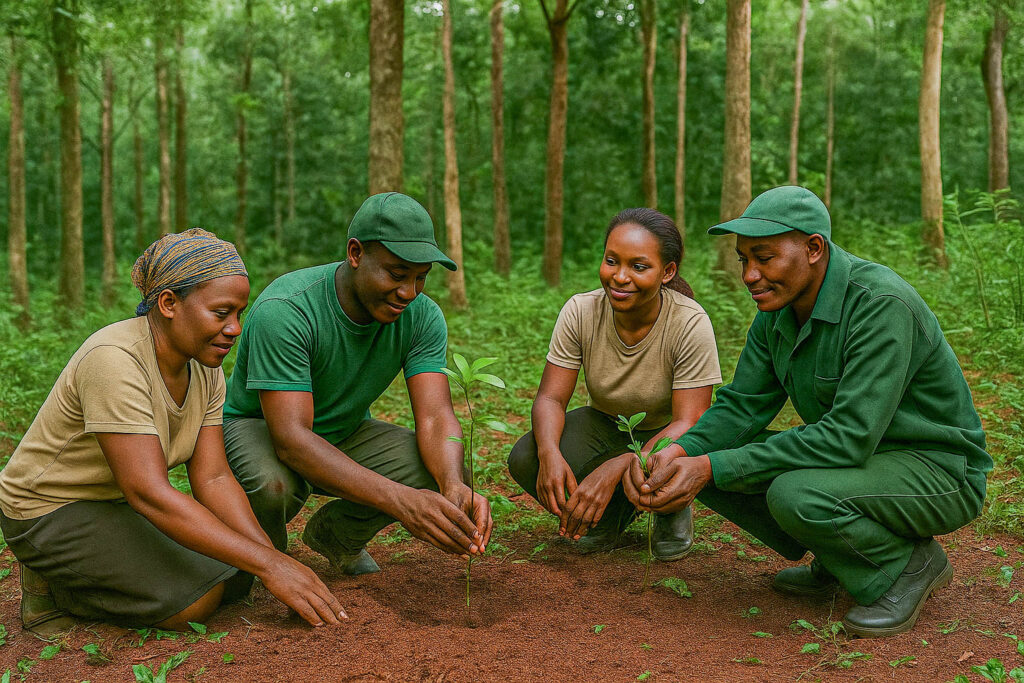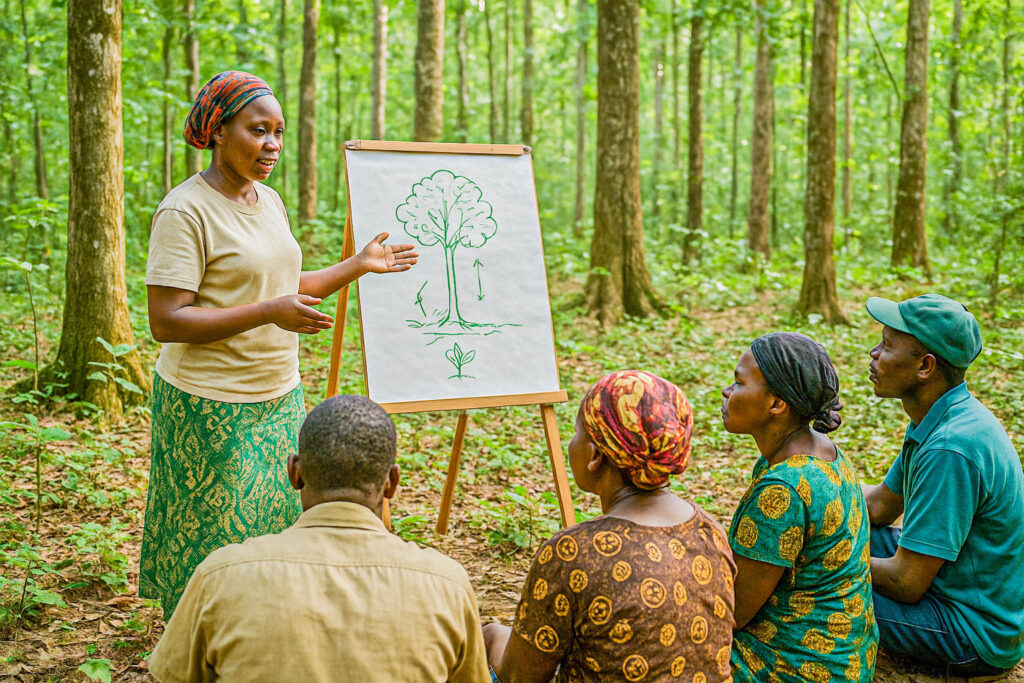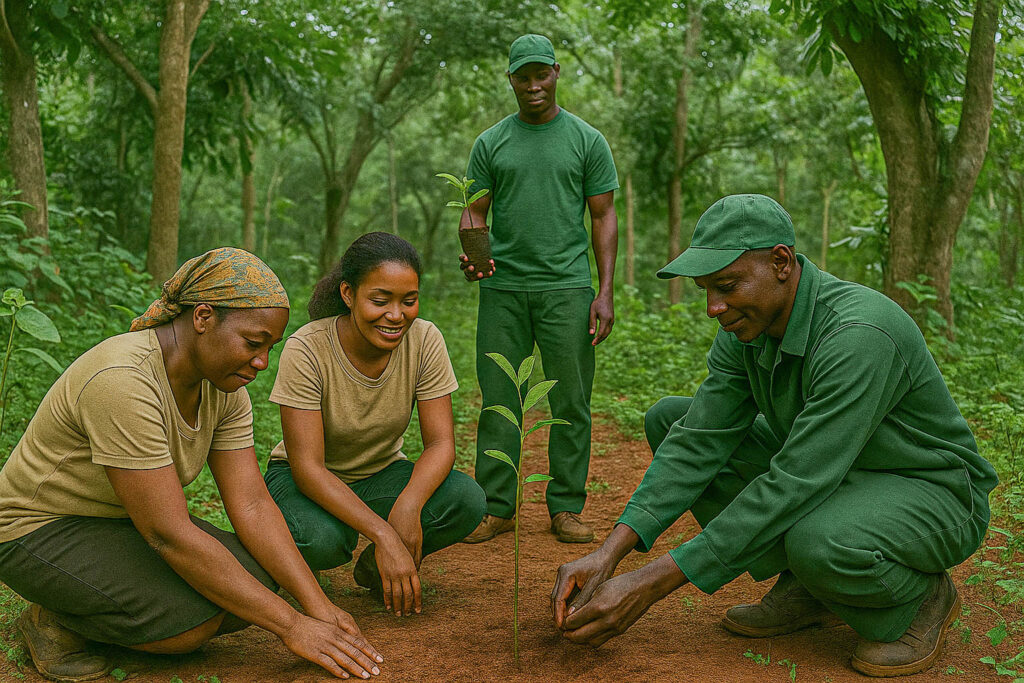Sustainable Value Chains – Transforming Forest Resources into Community Prosperity

Sustainable value chains represent the bridge between forest conservation and economic development, demonstrating that environmental protection and community prosperity are not only compatible but mutually reinforcing. Our sustainable value chain programs create economic incentives for forest conservation while generating meaningful income for forest-dependent communities.
The traditional approach to forest use often creates a false choice between conservation and development. Our sustainable value chain model proves that forests are more valuable standing than cleared, generating sustainable income streams that increase over time rather than providing one-time gains from destructive practices. By developing comprehensive value chains for forest products and services, we create long-term economic foundations that support both community development and forest conservation.
Across our operational areas, we work with communities to identify, develop, and scale sustainable forest-based enterprises that provide stable incomes while maintaining ecosystem integrity. Our approach recognizes that sustainable value chains must be built on strong foundations of community ownership, technical knowledge, and market access.
Forest Product Development
Identifying High-Value Forest Resources Forest ecosystems provide an extraordinary diversity of products with economic potential, from traditional timber and non-timber forest products to emerging opportunities in ecosystem services and bio-based industries. Our forest product development programs begin with comprehensive assessments that identify the most promising opportunities for sustainable commercialization.
Resource Assessment and Inventory We conduct participatory resource assessments that combine scientific surveys with traditional knowledge:
- Forest Inventory Systems: We establish systematic forest inventories that quantify available resources while tracking their regeneration rates and sustainable harvest levels. This includes detailed assessments of timber species, medicinal plants, fruits, nuts, and other non-timber forest products.
- Traditional Knowledge Documentation: We work with community elders and traditional healers to document traditional uses and management practices for forest products, ensuring this knowledge informs sustainable development strategies.
- Market Research Integration: We combine resource assessments with market research to identify products with strong commercial potential and growing demand in local, national, and international markets.
- Sustainability Analysis: Every potential forest product undergoes sustainability analysis to determine harvest levels that maintain ecosystem health and ensure long-term availability.
Timber and Wood Products Development Sustainable timber management provides significant income potential while maintaining forest cover:
- Selective Harvesting Systems: We develop community-managed selective harvesting systems that remove individual trees while maintaining forest canopy and biodiversity. These systems often generate higher long-term returns than clear-cutting approaches.
- Value-Added Processing: We support communities to develop local wood processing capabilities, from basic carpentry to specialized furniture and craft production, capturing more value locally rather than exporting raw materials.
- Sustainable Certification: We help communities achieve forest certification under systems like FSC (Forest Stewardship Council) that provide market premiums and ensure sustainable practices.
- Plantation Development: Where appropriate, we support establishment of community-managed timber plantations using native species that provide income while reducing pressure on natural forests.
Non-Timber Forest Products (NTFPs) NTFPs often provide higher income per hectare than timber while requiring minimal forest disturbance:
- Medicinal Plants: We develop sustainable production systems for medicinal plants, including wild harvesting guidelines, cultivation techniques, and processing methods that maintain product quality and potency.
- Forest Foods: We support commercialization of forest foods including fruits, nuts, mushrooms, and honey, developing processing and preservation techniques that extend shelf life and add value.
- Craft Materials: We work with artisans to develop sustainable sources of craft materials including fibers, dyes, and carving materials, supporting traditional crafts while creating market opportunities.
- Essential Oils and Cosmetics: We develop extraction and processing capabilities for essential oils, cosmetic ingredients, and natural fragrances derived from forest plants.
Ecosystem Services Monetization Forests provide valuable services that can generate income for communities:
- Carbon Credit Development: We develop forest carbon projects that generate certified emission reductions, providing ongoing income for forest protection and restoration activities.
- Payment for Ecosystem Services: We facilitate agreements where downstream water users pay forest communities for watershed protection services that ensure water quality and availability.
- Biodiversity Conservation Payments: We connect communities with conservation organizations and government programs that provide payments for protecting critical habitats and endangered species.
- Research and Education Services: We help communities develop income from hosting researchers, students, and educational programs that study forest ecosystems.
Community Income Generation
Creating Diverse Economic Opportunities Sustainable forest-based economies require diversification beyond forest products to include services and activities that complement forest conservation. Our community income generation programs create multiple livelihood options that reduce dependence on any single source of income while maintaining forest cover.
Eco-Tourism Development Community-based eco-tourism provides significant income potential while creating strong incentives for forest conservation:
- Tourism Product Development: We help communities identify and develop their unique tourism assets, including wildlife viewing opportunities, cultural experiences, forest hiking trails, and traditional ceremonies.
- Infrastructure Development: We support development of appropriate tourism infrastructure including community guesthouses, camping facilities, and interpretive centers that provide visitor amenities while maintaining environmental integrity.
- Guide Training Programs: We train community members as professional guides who can provide high-quality experiences for visitors while sharing traditional knowledge about forest ecosystems and local culture.
- Marketing and Promotion: We help communities develop marketing strategies and materials, establish online presence, and connect with tour operators and travel agencies to attract visitors.
Sustainable Agriculture Integration Agriculture can complement rather than compete with forest conservation when properly designed:
- Agroforestry Systems: We support farmers to integrate trees into agricultural systems, providing additional income from tree products while improving soil fertility and water retention.
- Forest-Adjacent Agriculture: We promote agricultural practices on already-cleared land that minimize further forest conversion while maximizing productivity through sustainable intensification techniques.
- Organic and Specialty Crops: We help farmers transition to organic production and develop specialty crops that command premium prices and reduce environmental impact.
- Value-Added Processing: We support development of local processing capabilities for agricultural products, including fruit processing, grain milling, and traditional food preparation.
Forest-Based Enterprise Development We support communities to establish and manage enterprises based on forest resources:
- Community Cooperatives: We help establish community cooperatives that collectively manage forest resources and enterprises, sharing costs and benefits while building collective bargaining power.
- Women’s Enterprise Groups: We specifically support women’s groups to develop forest-based enterprises, recognizing women’s often specialized knowledge of forest resources and their central role in community economic development.
- Youth Enterprise Programs: We create opportunities for young people to engage in forest-based enterprises as an alternative to urban migration, maintaining community cohesion while providing economic opportunities.
- Microfinance Support: We facilitate access to microfinance and savings programs that provide capital for enterprise development and expansion.
Sustainable Harvesting Practices
Building Technical Capacity for Long-Term Sustainability Sustainable harvesting requires sophisticated understanding of forest ecology, species biology, and regeneration patterns. Our training programs build community capacity to harvest forest resources in ways that maintain ecosystem health and ensure long-term productivity.
Ecological Harvesting Principles We train communities in ecological principles that guide sustainable harvesting:
- Regeneration Requirements: Understanding the specific conditions each species requires for regeneration, including light levels, soil conditions, and dispersal mechanisms.
- Sustainable Yield Calculations: Training communities to calculate sustainable harvest levels based on population assessments, growth rates, and regeneration success.
- Ecosystem Impact Assessment: Understanding how harvesting activities affect broader ecosystem functions and other species that depend on harvested resources.
- Seasonal Timing: Identifying optimal harvest times that maximize product quality while minimizing impact on species reproduction and ecosystem functions.
Species-Specific Harvesting Techniques Different forest products require specific harvesting approaches:
- Medicinal Plant Harvesting: Training in proper harvesting techniques for medicinal plants, including which plant parts to harvest, optimal timing, and regeneration management to ensure continued availability.
- Fruit and Nut Collection: Developing harvesting techniques that maximize product quality while ensuring tree health and continued production, including proper climbing techniques and post-harvest handling.
- Timber Harvesting: Training in selective harvesting techniques that minimize forest disturbance while ensuring worker safety and product quality.
- Mushroom and Fungi Harvesting: Teaching sustainable harvesting practices for wild mushrooms and other fungi that maintain habitat conditions necessary for continued production.
Harvesting Equipment and Tools We provide training and access to appropriate harvesting tools and equipment:
- Safety Equipment: Ensuring all harvesters have access to appropriate safety equipment including protective clothing, climbing gear, and first aid supplies.
- Quality Maintenance Tools: Providing tools and training for proper product handling, storage, and initial processing to maintain quality and maximize value.
- Low-Impact Techniques: Training in harvesting techniques that minimize forest disturbance, including trail design, selective cutting methods, and restoration practices.
Monitoring and Adaptive Management Sustainable harvesting requires ongoing monitoring and adjustment:
- Population Monitoring: Training communities to monitor populations of harvested species and adjust harvest levels based on population trends.
- Impact Assessment: Regular assessment of harvesting impacts on target species and broader ecosystem health, with adjustments to practices as needed.
- Record Keeping: Establishing simple record-keeping systems that track harvest levels, regeneration success, and long-term trends.
Market Access Facilitation
Connecting Communities to Value-Adding Markets Even the highest quality forest products generate limited income if communities lack access to appropriate markets. Our market access programs connect community producers with buyers who value sustainable products and are willing to pay fair prices for quality goods.
Market Analysis and Development We conduct comprehensive market analysis to identify the best opportunities for community products:
- Market Demand Assessment: Analyzing current and projected demand for forest products in local, national, and international markets, identifying gaps that community producers can fill.
- Price Analysis: Tracking price trends for forest products across different markets to identify opportunities for maximizing community returns.
- Competition Analysis: Understanding the competitive landscape for forest products and identifying strategies for community products to compete effectively.
- Consumer Preference Research: Understanding what consumers value in forest products, including quality standards, packaging preferences, and certification requirements.
Certification and Standards Support Certification can provide market access and price premiums for sustainable forest products:
- Organic Certification: Supporting communities to achieve organic certification for forest products where appropriate, including training in organic production practices and certification process navigation.
- Fair Trade Certification: Helping communities achieve fair trade certification that guarantees fair prices and supports community development programs.
- Forest Certification: Supporting forest management certification under systems like FSC that provide market access and price premiums for sustainably produced timber and NTFPs.
- Quality Standards Compliance: Training communities in quality standards required for different markets, including product handling, storage, and processing requirements.
Value Addition and Processing Adding value to forest products before sale can significantly increase community income:
- Processing Equipment: Providing access to appropriate processing equipment for activities like oil extraction, dried fruit production, and handicraft creation.
- Packaging and Branding: Supporting communities to develop attractive packaging and branding for their products that communicate quality and sustainability values.
- Product Development: Working with communities to develop new products and product variations that meet specific market demands and command higher prices.
- Quality Control Systems: Establishing quality control systems that ensure consistent product quality and build buyer confidence in community products.
Buyer Relationship Development Building strong relationships with buyers is essential for sustainable market access:
- Buyer Identification: Identifying potential buyers who value sustainability and are committed to long-term purchasing relationships with community producers.
- Contract Negotiation: Supporting communities in negotiating fair contracts that provide price stability and long-term market security.
- Relationship Management: Training communities in buyer relationship management including communication, order fulfillment, and quality assurance.
- Payment Systems: Establishing secure and efficient payment systems that ensure communities receive prompt payment for their products.
Integrated Value Chain Development and Impact
Comprehensive Value Chain Approach Our sustainable value chain programs achieve maximum impact through integration of product development, income generation, sustainable harvesting, and market access. This comprehensive approach ensures that communities have the knowledge, skills, and connections necessary to build thriving forest-based economies.
Measured Economic and Environmental Outcomes Our sustainable value chain programs have generated significant measurable results:
- Income Generation: Created sustainable income streams totaling over $1.2 million annually for forest communities, with individual households averaging 45% increases in forest-based income.
- Enterprise Development: Supported establishment of 87 community-based forest enterprises, including 23 cooperatives and 34 women’s groups engaged in forest product commercialization.
- Market Access: Connected community producers with 156 buyers across local, national, and international markets, establishing long-term purchasing relationships.
- Value Addition: Established 31 community processing facilities that add value to forest products, capturing an average of 280% more value compared to selling raw materials.
- Certification Achievement: Supported 12 communities to achieve forest or product certification, resulting in average price premiums of 25-40% for certified products.
- Forest Conservation: Maintained forest cover across 34,000 hectares through sustainable use programs that demonstrate forests are more valuable standing than cleared.
Sustainability and Scaling Our sustainable value chain programs are designed for long-term sustainability and replication. By building community ownership, technical capacity, and market relationships, we create foundations for continued growth and expansion. Through partnerships with government agencies, private sector buyers, and development organizations, we work to scale successful value chain models to benefit additional communities and forest areas.
Sustainable value chains represent a powerful tool for achieving conservation and development goals simultaneously. Through our comprehensive programs, we demonstrate that forest conservation can be economically attractive, socially beneficial, and environmentally sustainable, creating models for forest-based development that can be replicated across Africa and other forest regions worldwide.






Responses